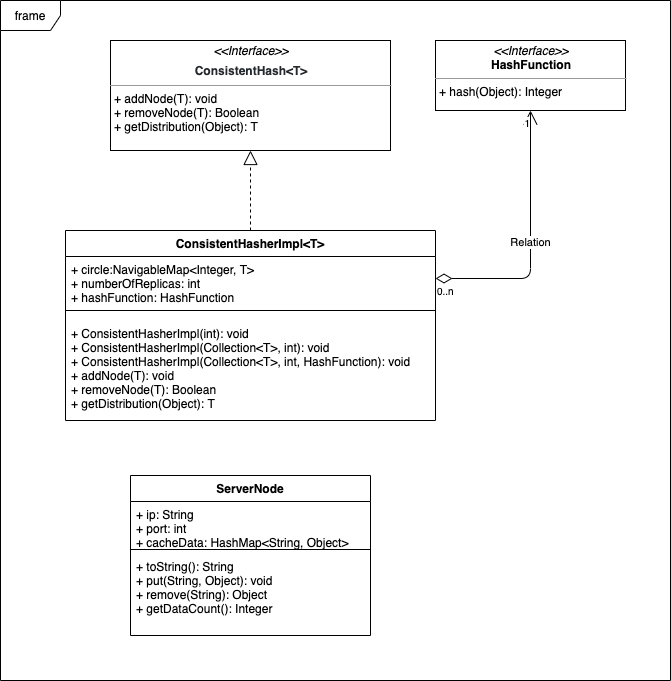架构师训练营 -Week 05 命题作业
发布于: 2020 年 07 月 08 日
用你熟悉的编程语言实现一致性 hash 算法。
编写测试用例测试这个算法,测试 100 万 KV 数据,10 个服务器节点的情况下,计算这些 KV 数据在服务器上分布数量的标准差,以评估算法的存储负载不均衡性。
类图:

HashFunction接口类:
public interface HashFunction { Integer hash(Object key);}ConsistentHash接口类:
public interface ConsistentHash<T> { public void addNode(T node); public Boolean removeNode(T node); public T getDistribution(Object key);}ConsistentHashImpl类
public class ConsistentHashImpl<T> implements ConsistentHash<T> { private NavigableMap<Integer, T> circle = new TreeMap<>(); private Integer numberOfReplicas; private HashFunction hashFunction; public ConsistentHashImpl(Integer numberOfReplicas) { this(null, numberOfReplicas, null); } public ConsistentHashImpl(Collection<T> nodes, Integer numberOfReplicas) { this(nodes, numberOfReplicas, null); } public ConsistentHashImpl(Collection<T> nodes, int numberOfReplicas, HashFunction hashFunction) { this.numberOfReplicas = numberOfReplicas > 1 ? numberOfReplicas : 1; if (nodes != null) { for (T node: nodes) { addNode(node); } } if (hashFunction == null) { this.hashFunction = new HashFunction() { @Override public Integer hash(Object key) { return HashUtil.fnvHash(key.toString()); } }; } } @Override public void addNode(T node) { if (node == null) { return; } for (int i = 1; i <= numberOfReplicas; i++) { this.circle.put(hashFunction.hash(node.toString() + i), node); } } @Override public Boolean removeNode(T node) { if (node != null) { for (int i = 1; i <= numberOfReplicas; i++) { this.circle.remove(hashFunction.hash(node.toString() + i)); } } return true; } @Override public T getDistribution(Object key) { if (key == null) { throw new NullPointerException("key can not be null."); } if (this.circle.isEmpty()) { return null; } Integer hash = hashFunction.hash(key); SortedMap<Integer, T> tailMap = this.circle.tailMap(hash); Integer matchNodeHash = tailMap.isEmpty() ? this.circle.firstKey() : tailMap.firstKey(); return this.circle.get(matchNodeHash); } public NavigableMap<Integer, T> getCircle() { return this.circle; }}ServerNode类:
public class ServerNode { private String ip; private int port; private Map<String, Object> cacheData = new HashMap<>(); public ServerNode(String ip, int port) { this.ip = ip; this.port = port; } @Override public String toString() { return new StringBuilder().append(ip).append(":").append(port).toString(); } public void put(String key, Object value) { this.cacheData.put(key, value); } public Object remove(String key) { return cacheData.remove(key); } public Integer getDataCount() { return cacheData.size(); }}
测试:
public class ConsistentHashImplTest { public static final String[] ips = new String[]{ "192.168.0.10", "192.168.0.11", "192.168.0.12", "192.168.0.13", "192.168.0.14", "192.168.0.15", "192.168.0.16", "192.168.0.17", "192.168.0.18", "192.168.0.19" }; public static final int port = 8000; @Test public void testFnvHashBalance() { // 每个服务器节点对应10个虚拟节点 ConsistentHash<ServerNode> consistentHash = new ConsistentHashImpl<>(10); test(consistentHash); } private void test(ConsistentHash<ServerNode> consistentHash) { List<ServerNode> nodeList = new ArrayList<>(ips.length); for (String ip : ips) { ServerNode serverNode = new ServerNode(ip, port); consistentHash.addNode(serverNode); nodeList.add(serverNode); } // 打印虚拟节点分布 NavigableMap<Integer, ServerNode> circle = ((ConsistentHashImpl<ServerNode>) consistentHash).getCircle(); Iterator<Integer> it = circle.keySet().iterator(); int num = 1; while(it.hasNext()) { Integer i = it.next(); System.out.printf("第%s个虚拟节点, 服务器【%s】\n", num++, circle.get(i).toString()); } // 准备一百万条数据,用一致性分布算法分布在服务器上 for (int i = 0; i < 1000000; i++) { String key = String.valueOf(i); String value = RandomUtil.randomString(6); consistentHash.getDistribution(key).put(key, value); } // 打印分布 for (ServerNode serverNode : nodeList) { System.out.printf("服务器【%s】节点存储(%s)条数据\n", serverNode.toString(), serverNode.getDataCount()); } // 标准差计算 int total = nodeList.stream().mapToInt(ServerNode::getDataCount).sum(); double avg = total * 1.0 / nodeList.size(); double sum = nodeList.stream().mapToDouble(node -> Math.pow((node.getDataCount() * 1.0) - avg, 2)).sum(); double standardDeviation = Math.sqrt(sum / nodeList.size()); System.out.printf("标准差:%s", String.valueOf(standardDeviation)); } /* 结果: 哈希算法:FnvHash 虚拟节点数:100 每个服务器节点对应10个虚拟节点 服务器【192.168.0.10:8000】节点存储(79204)条数据 服务器【192.168.0.11:8000】节点存储(77773)条数据 服务器【192.168.0.12:8000】节点存储(151707)条数据 服务器【192.168.0.13:8000】节点存储(128070)条数据 服务器【192.168.0.14:8000】节点存储(73088)条数据 服务器【192.168.0.15:8000】节点存储(99577)条数据 服务器【192.168.0.16:8000】节点存储(120744)条数据 服务器【192.168.0.17:8000】节点存储(94620)条数据 服务器【192.168.0.18:8000】节点存储(86496)条数据 服务器【192.168.0.19:8000】节点存储(88721)条数据 标准差:24251.429566110117 */
划线
评论
复制
发布于: 2020 年 07 月 08 日 阅读数: 32
华乐彬
关注
还未添加个人签名 2019.03.13 加入
还未添加个人简介









评论